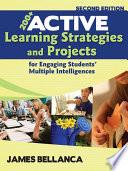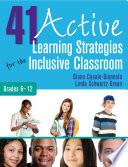Sebanyak 67 item atau buku ditemukan
Organized by intelligence area, this resource provides more than 200 new and enhanced strategies to help teachers increase students' motivation and transform them into active learners.
Keys to engaging secondary students Research shows that all students—regardless of learning style, disability category, or language difference—learn more effectively when they are engaged in active learning. This book shows teachers how to help all students achieve positive learning outcomes. The authors provide a compilation of strategies that serve as blueprints for instructional design and directions for using them across a variety of content areas. The many benefits of active learning include: A more engaged and interactive classroom Increased self-directed learning Development of higher-order thinking skills such as analysis, synthesis, evaluation Improved reading, discussion, and writing competencies
All teachers question how they can meet the needs of all learners, but middle
school and high school classrooms are content intensive. Teachers think about
whether they need to take more time to teach material, and if so, will there be
enough ...
Engage all learners with research-based strategies from acclaimed educators Research indicates that students of all ages and demographics benefit from active learning methods. Award-winning educators Linda Schwartz Green and Diane Casale-Giannola connect research and application with more than 40 easy-to-implement strategies for today’s inclusive classroom. This practical guide includes: Field-tested practices that are easily adaptable to various grade levels and subjects Vignettes that demonstrate how to apply today’s brain-compatible strategies in the classroom Tools for differentiating instruction to serve ALL students, including high-ability students, those with ADHD or learning disabilities, and English learners
We have, thankfully, entered a new century of learning in which classrooms
include students of all abilities. Inclusion is not a fad; it is an ongoing philosophy
that invites and prepares children to prosper beyond classroom walls into
accepting ...
Five Essentials for Your Teaching Plan
Translating brain research into best practice, this book offers teachers a concise Strategic Learning Model for the active transfer of knowledge to students' long-term memory.
SUMMARY Powering Up is the point in the lesson when we pull students into the
learning by tapping into what they already know and by creating a hook to the
new learning. About 98% of all new learning comes to us through the senses—all
...
This revised edition of Multiple Intelligences in the Mathematics Classroom provides ready-to-use lessons aligned with NCTM content standards to help students gain meaningful understandings of key mathematical concepts.
The five Content Standards—number and operations, algebra, geometry,
measurement, and data analysis and probability—clearly describe the content
that students should learn. The five Process Standards— problem solving,
reasoning and ...
...With Strategies for the Classroom
This updated edition provides information about common exceptionalities, ADHD and bipolar disorder, legal considerations, and discussions on postsecondary transition, NCLB, and the reauthorization of IDEA 2004.
In 2003, a study was conducted to examine the effects of reading on children with
dyslexia at the Academy of Neurology. ... of the following characteristics: •
Inability to learn and remember words by sight • Difficulty in decoding skills •
Difficulty ...
Practices, Programs, Policies, and Philosophies
Highlights include a comprehensive exploration of more than 60 proven practices, results-oriented programs, policies, and innovative movements/theories.
They use cues from print, such as configuration clues and context clues, to
decode words. They are taught to recognize ... decode unfamiliar words. Reading
, oral, and written language are considered as a whole rather than as separate
skills.







